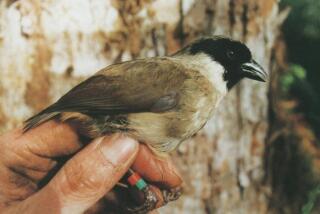Imported Weeds Plant Nasty Roots in U.S.
- Share via
WASHINGTON — Gardeners searching their catalogues for a hardy, tall wildflower might want to try the giant hogweed, with its large, maplelike leaves and broad umbrella-like clusters of small, white flowers.
No matter that the federal government bans import of the Caucasus native as a “noxious weed” worse than poison ivy. The hogweed is already here and, because of the way the Agriculture Department views federal law, it won’t stop hogweed shipments from one state to another.
That kind of loophole could close. Aware of billions of dollars in damage that weeds can cause, the department and Congress are working on ways to keep more plants out of this country and to restrict the movement of weeds already here.
The changes are long overdue, said Howard M. Singletary Jr., director of the plant industry division of the North Carolina Department of Agriculture. Compared with such undesirable pests as Mediterranean fruit flies and gypsy moths, imported weeds have gotten short shrift.
“They receive less attention because they do not creep, crawl or fly and in many cases take longer to establish and begin to proliferate,” he said.
But the Weed Science Society of America estimates annual crop losses and herbicide costs from non-native weeds at $3.6 billion to $5.4 billion a year, Singletary noted in recent testimony before the Senate Governmental Affairs Committee. That does not include the impact on natural areas, human health and government spending.
Prompted by a report from the Congressional Office of Technology Assessment, the committee is looking at the threat from thousands of foreign pests, from microbial pesticides to zebra mussels.
Weeds are an important but neglected component, the report said.
“Weed control programs throughout federal agencies are generally small and underfunded,” OTA researcher Phyllis Windle told the committee.
According to the technology office, the government has made little use of the Federal Noxious Weed Control Act, a 20-year-old law.
The Agriculture Department’s Animal and Plant Health Inspection Service took eight years to put 93 species on the list, although 750 additional species would qualify, the report said.
The inspection service has tried to quarantine only one noxious plant, witchweed, which has plagued the Carolinas since the 1950s. Because of its possible threat to corn, the nation’s most important crop, the department has worked with North and South Carolina to wipe out the pest.
Without a quarantine effort under way, the inspection service won’t try to halt the interstate movement of plants. But quarantines are expensive, difficult and sometimes unpopular.
Those loopholes mean no federal rules will keep a thorny new pest known as the tropical soda apple from moving out of Florida, where it is taking over large areas of pastureland. The plant could be spread by the dung from cows that are able to eat the plants at certain times. A quarantine could hinder the movement of cattle outside the state.
The technology office report urged the weed act to restrict native U.S. plants that could be pests if taken outside where they normally grow. Pests that afflict non-farmland also would be included.
“It doesn’t make much sense to be able to work on a weed only in agricultural production areas when you go up to the boundary of a parkland and can’t do it just across the park,” said B. Glen Lee, deputy administrator for plant protection and quarantine at the inspection service.
In the meantime, gardeners can still buy purple loosestrife for its long spires of closely set small flowers. Tolerant of wet areas and suitable for wild settings, the weed has already spread to 37 states. It cost Minnesota $500,000 to control between 1987 and 1991. But it hasn’t made the federal weed list yet.
More to Read
Sign up for Essential California
The most important California stories and recommendations in your inbox every morning.
You may occasionally receive promotional content from the Los Angeles Times.














